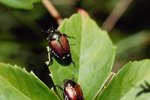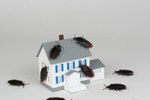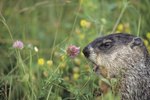
As late summer rolls around, grubs like to get to work on your lawn. They aren't exactly helpful, however, as they nibble away roots and cause your pretty green grass to start looking wilted and brown. Even worse, they attract predators that tear into the turf in their determination to find a good meal. While the damage is frustrating, grubs are an important dietary source of protein and calories to many species.
Skunks and Raccoons
Opportunists like skunks and raccoons have adapted well to urban living, including finding food in lawns and flower beds. They both eat grubs, which removes them from your yard, but can also cause a lot damage. Raccoons and skunks have learned to pull up grass or roll it back to get to the little grubs. They also dig holes or yank out patches of turf in their search for food. Generally, raccoons will peel back large sections while skunks make dozens of small holes.
Moles
Moles are often blamed for the damage caused by grubs. Often the presence of grubs is what attracts moles to a yard in the first place. Although moles tear up a lawn in their search for food, which also includes earthworms, the grass roots were already weakened by grubs, making the damage much worse. Signs of mole damage include tunnels, holes and small mounds of soil or molehills. Even if the grubs are killed or removed, moles are likely to return to the area for the earthworms.
Birds
Birds enjoy a meal of grubs, and fortunately they can usually pick out the grubs without serious damage to the lawn. In fact, the pecking can help aerate the turf as they remove the damaging pests. Birds are a good non-chemical option for controlling grubs. Large birds or those that travel in big flocks, like crows and starlings, can cause some damage. Crows will tear out patches of grass to get at grubs, while a flock of starlings can rip away grass with weak roots, leaving behind bare areas.
Humans
Hopefully your neighbor isn't tearing up your lawn to get to them, but people do eat grubs in many parts of the world. A person who eats insects like grubs is known as an entomophagist, and in 80 percent of the world's nations insects are a common part of the daily diet. Insects, including grubs, are high in protein and are often touted as a green alternative to methane-producing livestock. According to the University of Maryland, a serving of 10 large witchetty grubs furnishes all the daily protein and calorie needs of an average adult.
References
- University of Illinois Extension: White Grubs in Lawns
- University of Illinois Extension: Insect Damage
- Ottowa-Carleton Wildlife Centre: Animal Digging My Lawn
- McGill University: Beetle Grubs
- P. Allen Smith: Japanese Beetles
- Columbia Daily Tribune: How to Control Moles and Reduce Lawn Damage
- The Guardian: Grubs Up: Eating Insects
- University of Maryland: Cicada-licious
Photo Credits
-
Hemera Technologies/PhotoObjects.net/Getty Images




